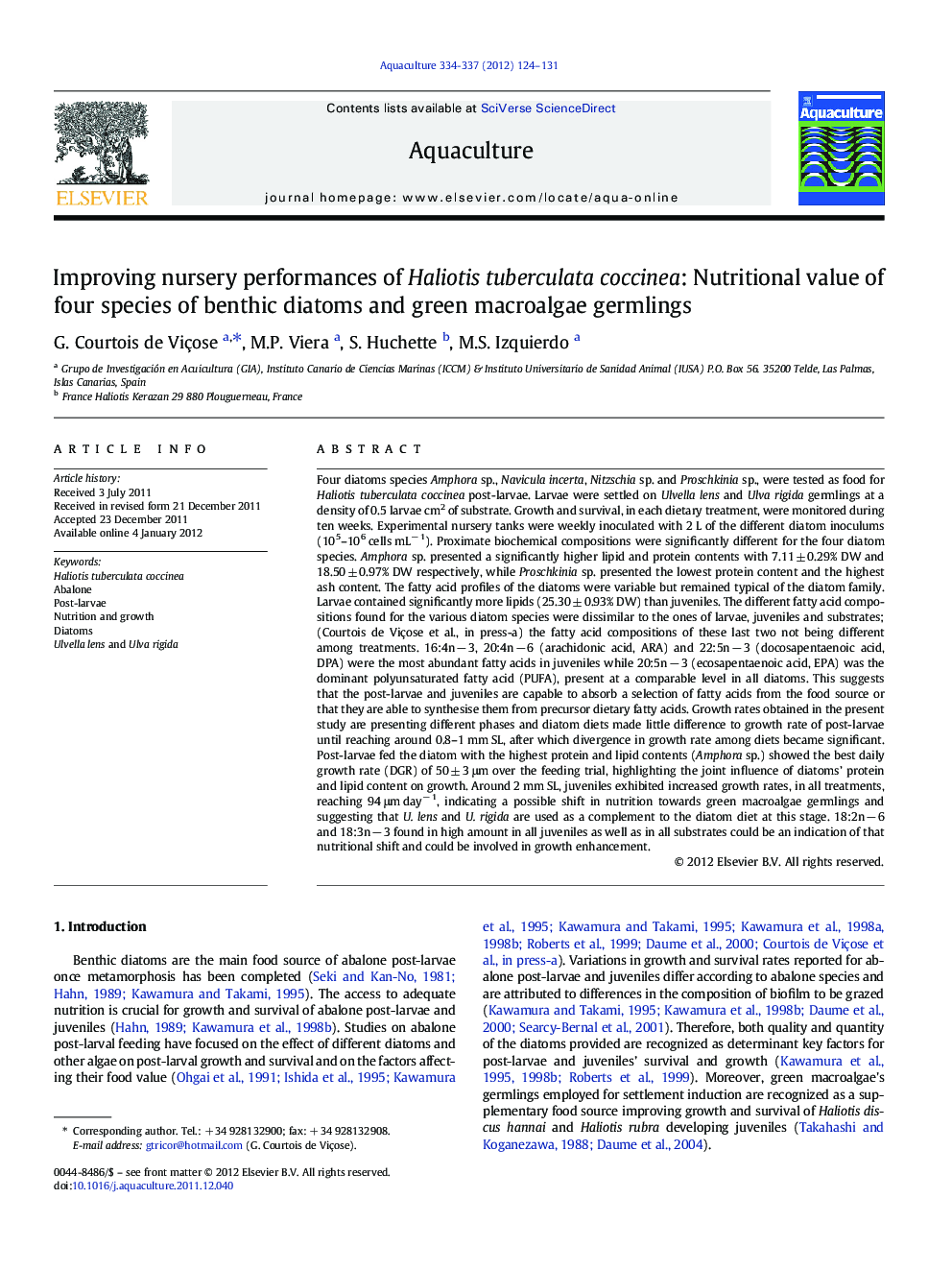| کد مقاله | کد نشریه | سال انتشار | مقاله انگلیسی | نسخه تمام متن |
|---|---|---|---|---|
| 2422709 | 1552894 | 2012 | 8 صفحه PDF | دانلود رایگان |

Four diatoms species Amphora sp., Navicula incerta, Nitzschia sp. and Proschkinia sp., were tested as food for Haliotis tuberculata coccinea post-larvae. Larvae were settled on Ulvella lens and Ulva rigida germlings at a density of 0.5 larvae cm2 of substrate. Growth and survival, in each dietary treatment, were monitored during ten weeks. Experimental nursery tanks were weekly inoculated with 2 L of the different diatom inoculums (105–106 cells mL− 1). Proximate biochemical compositions were significantly different for the four diatom species. Amphora sp. presented a significantly higher lipid and protein contents with 7.11 ± 0.29% DW and 18.50 ± 0.97% DW respectively, while Proschkinia sp. presented the lowest protein content and the highest ash content. The fatty acid profiles of the diatoms were variable but remained typical of the diatom family. Larvae contained significantly more lipids (25.30 ± 0.93% DW) than juveniles. The different fatty acid compositions found for the various diatom species were dissimilar to the ones of larvae, juveniles and substrates; (Courtois de Viçose et al., in press-a) the fatty acid compositions of these last two not being different among treatments. 16:4n − 3, 20:4n − 6 (arachidonic acid, ARA) and 22:5n − 3 (docosapentaenoic acid, DPA) were the most abundant fatty acids in juveniles while 20:5n − 3 (ecosapentaenoic acid, EPA) was the dominant polyunsaturated fatty acid (PUFA), present at a comparable level in all diatoms. This suggests that the post-larvae and juveniles are capable to absorb a selection of fatty acids from the food source or that they are able to synthesise them from precursor dietary fatty acids. Growth rates obtained in the present study are presenting different phases and diatom diets made little difference to growth rate of post-larvae until reaching around 0.8–1 mm SL, after which divergence in growth rate among diets became significant. Post-larvae fed the diatom with the highest protein and lipid contents (Amphora sp.) showed the best daily growth rate (DGR) of 50 ± 3 μm over the feeding trial, highlighting the joint influence of diatoms’ protein and lipid content on growth. Around 2 mm SL, juveniles exhibited increased growth rates, in all treatments, reaching 94 μm day− 1, indicating a possible shift in nutrition towards green macroalgae germlings and suggesting that U. lens and U. rigida are used as a complement to the diatom diet at this stage. 18:2n − 6 and 18:3n − 3 found in high amount in all juveniles as well as in all substrates could be an indication of that nutritional shift and could be involved in growth enhancement.
► Post-larvae fed Amphora sp. showed the best daily growth rate (DGR).
► Amphora sp. presented a significantly higher protein and lipid contents.
► Diatom diet and biochemical composition are important for early post-larval growth.
► Green macroalgae germlings are supplementary food source of good nutritional value.
► Control of substrates nutritional quality improves juveniles’ growth and production.
Journal: Aquaculture - Volumes 334–337, 7 March 2012, Pages 124–131